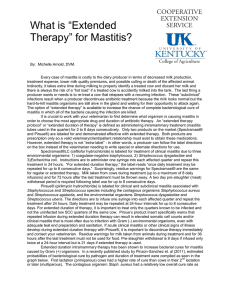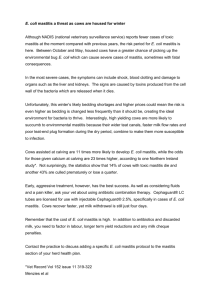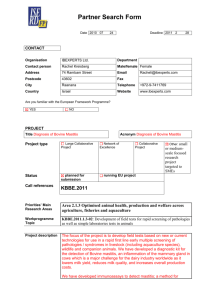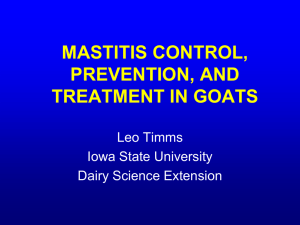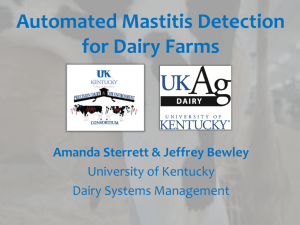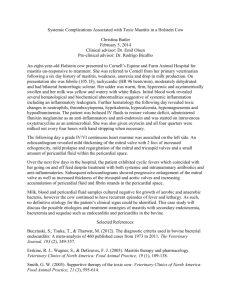Extended Therapy for Mastitis
advertisement
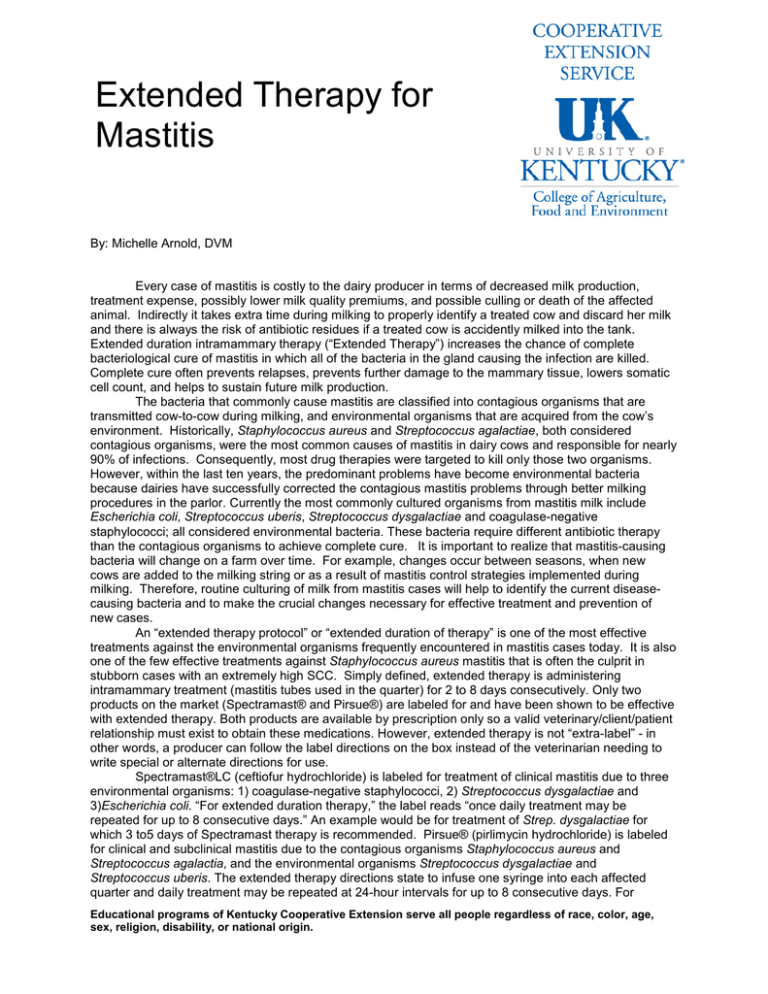
Extended Therapy for Mastitis By: Michelle Arnold, DVM Every case of mastitis is costly to the dairy producer in terms of decreased milk production, treatment expense, possibly lower milk quality premiums, and possible culling or death of the affected animal. Indirectly it takes extra time during milking to properly identify a treated cow and discard her milk and there is always the risk of antibiotic residues if a treated cow is accidently milked into the tank. Extended duration intramammary therapy (“Extended Therapy”) increases the chance of complete bacteriological cure of mastitis in which all of the bacteria in the gland causing the infection are killed. Complete cure often prevents relapses, prevents further damage to the mammary tissue, lowers somatic cell count, and helps to sustain future milk production. The bacteria that commonly cause mastitis are classified into contagious organisms that are transmitted cow-to-cow during milking, and environmental organisms that are acquired from the cow’s environment. Historically, Staphylococcus aureus and Streptococcus agalactiae, both considered contagious organisms, were the most common causes of mastitis in dairy cows and responsible for nearly 90% of infections. Consequently, most drug therapies were targeted to kill only those two organisms. However, within the last ten years, the predominant problems have become environmental bacteria because dairies have successfully corrected the contagious mastitis problems through better milking procedures in the parlor. Currently the most commonly cultured organisms from mastitis milk include Escherichia coli, Streptococcus uberis, Streptococcus dysgalactiae and coagulase-negative staphylococci; all considered environmental bacteria. These bacteria require different antibiotic therapy than the contagious organisms to achieve complete cure. It is important to realize that mastitis-causing bacteria will change on a farm over time. For example, changes occur between seasons, when new cows are added to the milking string or as a result of mastitis control strategies implemented during milking. Therefore, routine culturing of milk from mastitis cases will help to identify the current diseasecausing bacteria and to make the crucial changes necessary for effective treatment and prevention of new cases. An “extended therapy protocol” or “extended duration of therapy” is one of the most effective treatments against the environmental organisms frequently encountered in mastitis cases today. It is also one of the few effective treatments against Staphylococcus aureus mastitis that is often the culprit in stubborn cases with an extremely high SCC. Simply defined, extended therapy is administering intramammary treatment (mastitis tubes used in the quarter) for 2 to 8 days consecutively. Only two products on the market (Spectramast® and Pirsue®) are labeled for and have been shown to be effective with extended therapy. Both products are available by prescription only so a valid veterinary/client/patient relationship must exist to obtain these medications. However, extended therapy is not “extra-label” - in other words, a producer can follow the label directions on the box instead of the veterinarian needing to write special or alternate directions for use. Spectramast®LC (ceftiofur hydrochloride) is labeled for treatment of clinical mastitis due to three environmental organisms: 1) coagulase-negative staphylococci, 2) Streptococcus dysgalactiae and 3)Escherichia coli. “For extended duration therapy,” the label reads “once daily treatment may be repeated for up to 8 consecutive days.” An example would be for treatment of Strep. dysgalactiae for which 3 to5 days of Spectramast therapy is recommended. Pirsue® (pirlimycin hydrochloride) is labeled for clinical and subclinical mastitis due to the contagious organisms Staphylococcus aureus and Streptococcus agalactia, and the environmental organisms Streptococcus dysgalactiae and Streptococcus uberis. The extended therapy directions state to infuse one syringe into each affected quarter and daily treatment may be repeated at 24-hour intervals for up to 8 consecutive days. For Educational programs of Kentucky Cooperative Extension serve all people regardless of race, color, age, sex, religion, disability, or national origin. Extended Therapy for Mastitis example, Strep. uberis has a 70% cure rate with Pirsue if the cow receives 5 days of intramammary therapy. Work with your veterinarian to determine which cows would benefit from extended therapy and how many days of treatment are recommended to achieve complete cure. In summary, the benefits of extended therapy include: 1. Higher proportion of bacteriological cure caused by common mastitis organisms; 2. Reduced chance of relapse and treatment failure; 3. Decreased SCC; 4. Less risk of spread of contagious organisms, especially Staphylococcus aureus; 5. Improved marketability of milk. The drawbacks of extended therapy include: 1. Price of the medication (antibiotic tubes); 2. Loss of milk due to long treatment duration; 3. Risk of residues in milk and meat; 4. Potential to develop more mastitis due to repeated infusions; this is especially true with extended use of Pirsue®. Work with your veterinarian to determine the bacteria causing mastitis on your farm. Then, combine this information with the knowledge of the individual cow age, lactation status, treatment history, SCC, length of infection and overall health status to ultimately determine the best treatment decisions on your farm. Extended therapy may prove very helpful in eliminating bacteria that are difficult to cure such as Staph. aureus and Strep. uberis and preserve milk production in valuable cows. Ultimately, all antibiotic therapy should be reserved for cases that are most likely to benefit from it. Cows late in lactation and not pregnant, chronically ill, lame or not producing much milk should be considered potential culls rather than treatment candidates. Educational programs of Kentucky Cooperative Extension serve all people regardless of race, color, age, sex, religion, disability, or national origin.
